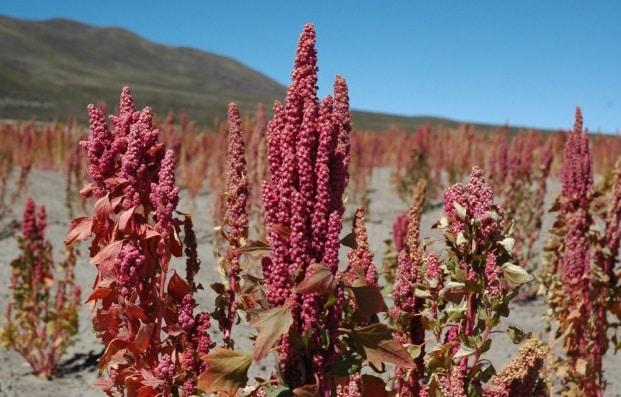How to Grow Quinoa in India: A Simple Guide for Farmers

Quinoa is a very healthy food that looks like a grain, but it is actually a seed that contains protein, fibre, and vitamins. People who care about their health love to eat this seed crop. Due to the sudden increase in demand, many farmers in India have started growing it. Also, the selling price is very good, which helps farmers earn a better income.
You can go through this guide to learn about the correct farming practices.
Process to Cultivate: From Soil Requirements to Post-Harvest
Quinoa farming has a few simple steps, from selecting the right soil to post-harvesting. The following are all the processes for successful cultivation.
Weather and Soil Requirements
Quinoa needs cool and dry weather. It grows best when the temperature is between 15°C and 30°C. The plant may not grow well if the weather is too hot, as the flowers may fall, and seeds may not form. This crop grows in many types of soil, including acidic soil. However, it must not hold too much water, or it will rot. So, the soil should be light, and water should drain out easily.
Prepare the Land
Before planting quinoa, the land must be prepared. First, farmers plough the land with a tractor to make the soil loose and soft. This helps the seeds grow better and makes it easy for water to spread. When the land is clean, soft, and flat, it is ready for planting the seeds.
Farmers can use the Solis 6024 S 4WD tractor for this process and easily plough the field 2 to 3 times. The powerful 60 HP engine can easily handle any implement and makes the soil loose. It also helps in breaking hard clumps and levelling the land. Additionally, the Solis 6024 S 4WD price ranges between Rs 9.90 and Rs 10.42 lakh.
Planting Seeds
Quinoa is usually planted in October or November. However, in some places, it is also planted in February. It takes about 3 to 4 months to grow. The seeds are very small, so farmers must plant them carefully. They use implements such as seed drills with the help of a tractor to plant seeds in straight lines. If there is no implement available, they can also sow them by hand. The seeds are planted with a small space between each plant and row.
Irrigation
Quinoa does not need much water, so it is good for places with little rain. Farmers water the field only two or three times, the first time after planting the seeds. The second time is when flowers appear, and the third time is when the seeds are growing. Too much water is bad for the plants, as the roots can get spoiled, so farmers should only give water when needed.
Taking Care of Weeds and Insects
Weeds are bad plants that grow near crops. They take away water and food from the soil. So, farmers must remove weeds at least two times. This can be done by hand or using small equipment. Sometimes, insects like aphids and worms can attack the quinoa plants. These insects eat the leaves and stop the plant from growing.
Farmers must check their fields often. If they see insects, they can use safe sprays to keep the plants safe. Taking care of the plants helps them grow better.
Using Manure and Fertilizer
Quinoa grows even better in poor soil, but if farmers give a little extra nutrient, the plants grow better. Before planting, they can add compost or cow dung to make the soil rich. Farmers can also add a little chemical fertilizer like nitrogen and potash. These help the plants grow fast and give more seeds. Too much can harm the plant, so fertilizer should be used in the right amount.
Harvesting
Quinoa is ready to cut in 3 to 4 months, when the plants change colour and the leaves dry up. The seeds become hard, and it is considered the best time to harvest. Farmers cut the plants with a sickle or similar equipment and let them dry in the sun.
Post Harvesting
After drying, they separate the seeds from the plant. Farmers must wash the seeds well in clean water to remove the cover. After washing and drying, the seeds are ready to be cooked or sold.
To efficiently transport the harvested quinoa, Solis 4014 E can prove to be very useful. It has a 2000 kg lifting capacity to handle heavy loads. The strong engine and smooth handling make it perfect for carrying over rough farm paths.
Conclusion
Quinoa farming is a smart choice for Indian farmers, especially in dry areas. It needs less water, grows well in poor soil, and gives a healthy and high-value crop. With proper care and simple practice, even new farmers can grow successfully. As more people choose nutritious food, the demand for this seed keeps growing.
- Art
- Causes
- Crafts
- Dance
- Drinks
- Film
- Fitness
- Food
- Games
- Gardening
- Health
- Home
- Literature
- Music
- Networking
- Other
- Party
- Religion
- Shopping
- Sports
- Theater
- Wellness
- Politics
- IT
- Relationship
- Blockchain
- NFT
- Crypto
- Fintech
- Automobile
- Faith
- Family
- Animals
- Travel
- Pets
- Coding
- Comedy
- Movie
- Game
- Computer



